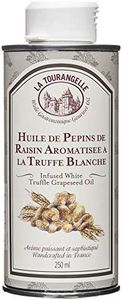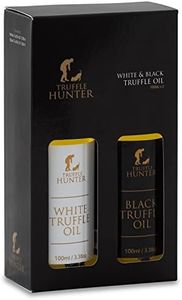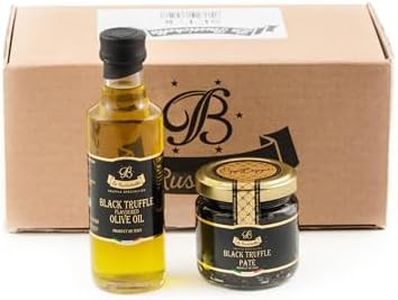We Use CookiesWe use cookies to enhance the security, performance,
functionality and for analytical and promotional activities. By continuing to browse this site you
are agreeing to our privacy policy
10 Best Truffle Oils
From leading brands and best sellers available on the web.By clicking on a link to a third party's website, log data is shared with that third party.
Buying Guide for the Best Truffle Oils
When choosing a truffle oil, it's important to understand what makes each bottle unique and how your preferences and intended use can influence your choice. Truffle oils are flavorful oils infused with the aroma and taste of truffles, which are rare and highly prized mushrooms. The right truffle oil can elevate salads, pastas, pizzas, and many other dishes with luxurious umami notes. To find the best fit for you, you'll want to look beyond just the label and pay attention to the details about ingredients, truffle type, and other specs, so your culinary experiences are truly enhanced.Type of Truffle UsedTruffle oil can be made using black truffles, white truffles, or a mix of both. Black truffle oils taste earthier and more robust, making them great for red meats, risottos, and hearty dishes. White truffle oils tend to be more delicate with garlicky and slightly peppery notes, often used for drizzling over pasta, eggs, or delicate vegetables. If you're unsure which direction to go, think about the kinds of foods you prepare most—choose white for lighter or subtler meals, black for foods with stronger flavors.
Ingredients and Infusion MethodThe best truffle oils are made using real truffle pieces or truffle extracts, rather than artificial flavors. Some bottles contain actual truffle pieces or natural truffle aroma derived from real fungi, while others are flavored solely with synthetic compounds. Oils with real truffle content provide a more authentic and well-rounded taste. To pick the right one, inspect the ingredient list; if authenticity and depth of flavor are important, look for natural ingredients and real truffle essence rather than artificial flavorings.
Base OilThe base oil in truffle oil is usually extra virgin olive oil, but sometimes other oils like sunflower or grapeseed oil are used. Olive oil-based truffle oils add fruity or peppery undertones and often have a richer mouthfeel, complementing Mediterranean dishes. Sunflower or grapeseed oil bases tend to have a milder, more neutral flavor, allowing the truffle aroma to stand out more. If you favor stronger, olive oil-like flavors or traditional uses, go with extra virgin olive oil. For a lighter base that lets truffle shine, try options made from milder oils.
Truffle IntensityTruffle oil comes in various strengths, from subtle hints to bold, pungent aromas. The intensity often depends on the amount or quality of truffle extract or pieces used in production. Light intensity pairs well with dishes where you want a delicate aroma, while higher intensity works for bold dishes or when you want the truffle flavor to be a standout note. Consider your taste preference—if you’re new to truffle oil, start with a lighter intensity. If you love the strong, unmistakable aroma, go for a more intense option.
Intended Use and PackagingTruffle oil can degrade in flavor and aroma if exposed to light, air, or heat. Packaging in dark, glass bottles helps preserve freshness, while specialized pour spouts or caps offer more control over drizzling. Some oils come in spray bottles for light, even application. Consider how you plan to use the oil: frequent drizzlers may benefit from larger bottles with good sealing caps, while occasional users might prefer smaller bottles to maintain freshness. Pick packaging that matches your cooking habits for the best experience.











